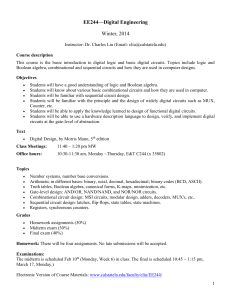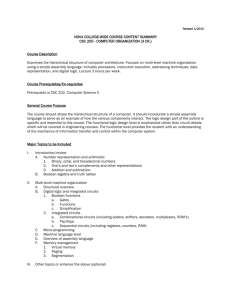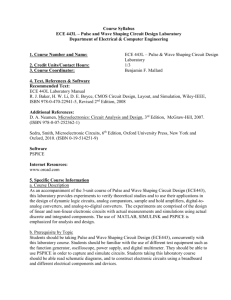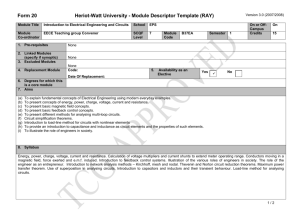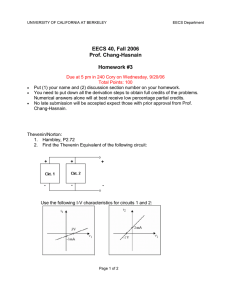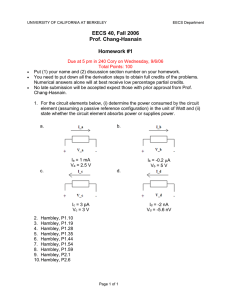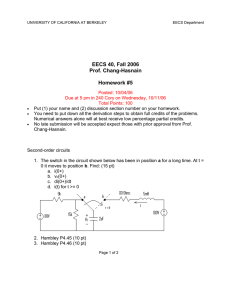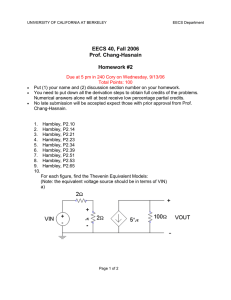Class Syllabus EE2001 : Introduction of Electronic and Electrical
advertisement
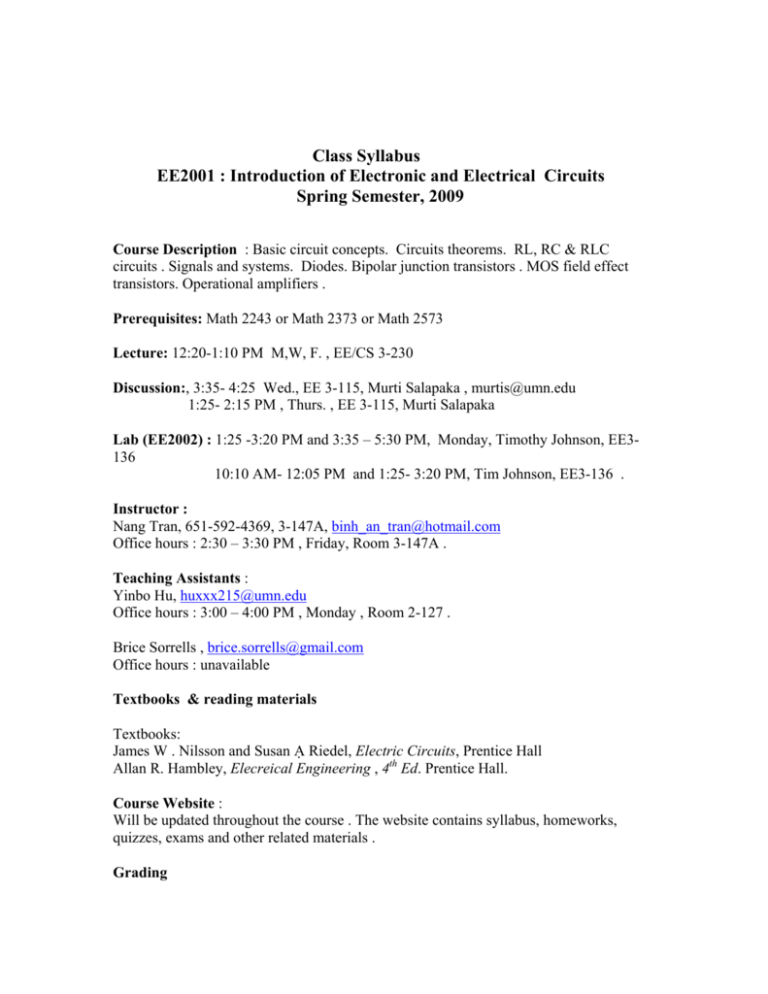
Class Syllabus EE2001 : Introduction of Electronic and Electrical Circuits Spring Semester, 2009 Course Description : Basic circuit concepts. Circuits theorems. RL, RC & RLC circuits . Signals and systems. Diodes. Bipolar junction transistors . MOS field effect transistors. Operational amplifiers . Prerequisites: Math 2243 or Math 2373 or Math 2573 Lecture: 12:20-1:10 PM M,W, F. , EE/CS 3-230 Discussion:, 3:35- 4:25 Wed., EE 3-115, Murti Salapaka , murtis@umn.edu 1:25- 2:15 PM , Thurs. , EE 3-115, Murti Salapaka Lab (EE2002) : 1:25 -3:20 PM and 3:35 – 5:30 PM, Monday, Timothy Johnson, EE3136 10:10 AM- 12:05 PM and 1:25- 3:20 PM, Tim Johnson, EE3-136 . Instructor : Nang Tran, 651-592-4369, 3-147A, binh_an_tran@hotmail.com Office hours : 2:30 – 3:30 PM , Friday, Room 3-147A . Teaching Assistants : Yinbo Hu, huxxx215@umn.edu Office hours : 3:00 – 4:00 PM , Monday , Room 2-127 . Brice Sorrells , brice.sorrells@gmail.com Office hours : unavailable Textbooks & reading materials Textbooks: James W . Nilsson and Susan Ạ Riedel, Electric Circuits, Prentice Hall Allan R. Hambley, Elecreical Engineering , 4th Ed. Prentice Hall. Course Website : Will be updated throughout the course . The website contains syllabus, homeworks, quizzes, exams and other related materials . Grading Homework : 15% Quizzes :20% (25% of the lowest grades will be discarded) Exam 1 : 15% Exam 2 : 20% Exam 3 : 30% For the homework, the students are encouraged to discuss with other students but copying others’ homework solutions is not allowed . Unless otherwise stated, homework is due on Monday. Late homework will not be accepted. The quizzes will be 30 minutes and a total of 8 quizzes will be given during the course. Definition of grades and workload expectations A -- achievement that is outstanding relative to the level necessary to meet course requirements. B -- achievement that is significantly above the level necessary to meet course requirements. C -- achievement that meets the course requirements in every respect. D -- achievement that is worthy of credit even though it fails to meet fully the course requirements. S -- achievement that is satisfactory, which is equivalent to a C- or better (achievement required for an S is at the discretion of the instructor but may be no lower than a C-). F (or N) -- Represents failure (or no credit) and signifies that the work was either (1) completed but at a level of achievement that is not worthy of credit or (2) was not completed and there was no agreement between the instructor and the student that the student would be awarded an I (see also I). Academic dishonesty: academic dishonesty in any portion of the academic work for a course shall be grounds for awarding a grade of F or N for the entire course. I -- (Incomplete) Assigned at the discretion of the instructor when, due to extraordinary circumstances, e.g., hospitalization, a student is prevented from completing the work of the course on time. Requires a written agreement between instructor and student. Diversity The University of Minnesota is committed to the policy that all persons shall have equal access to its programs, facilities and employment without regard to race, color, creed, religion, national origin, sex, age, marital status, disability, public assistance status, veteran status, or sexual orientation. All University faculty members, students, or staff members, and other individual engaged in any University activity or program are expected to respect diversity at all times. University of Minnesota Regents Policy on Diversity: http://www1.umn.edu/ohr/ohrpolicy/Diversity/ Accommodations for students with disabilities This publication/material is available in alternative formats upon request. Contact University of Minnesota Disability Services to receive accommodations and services (ds@umn.edu, 612-626-1333, http://ds.umn.edu/Students/Enrolled). Syllabus Subject to Change This syllabus may change as needed to support the learning objectives of this course. EE 2001 Spring 2009 Introduction to Electronic and Electrical Circuits Course Outline Basic Circuit Concepts: Nilsson: Chap. 1, 2, 3.1-3.5 Terminology, sign conventions, current and voltage sources, resistors, IV characteristics, Ohm's & Kirchoff's laws, resistor circuits Circuit Theorems: Nilsson: Chap. 4 Node and mesh analysis, source transformations, Thevenin's & Norton's theorems, maximum power transfer, superposition RL, RC & RLC Circuits: Nilsson: Chap. 6.1-6.3, 7.1-7.4, 8.1-8.2,8.4 Inductors and capacitors, IV characteristics, RL and RC circuits, natural and step response, RLC circuits Nilsson: Chap. 9.1 Hambley: Chap. 1.1, 1.4, 1.6, 1.7 Signals and Systems: Electronic systems overview, analog and digital signals, dc and ac signals, amplifier terminology Diodes: Hambley: Chap. 3.1-3.8 Ideal diode, IV characteristics, diode circuits, simple models, small-signal model, reverse-bias operation, rectifier circuits Bipolar Junction Transistor (BJT): Hambley: Chap. 13 Operating modes, npn and pnp transistor operation, IV characteristics, simple models, DC operation, basic amplifier, small-signal model, biasing, common-emitter amplifiers, emitter follower, BJT as switch, complete static characteristics Field Effect Transistor (FET): Hambley: Chap. 12 Operation, n-channel/p-channel & enhancement/depletion types, IV characteristics, DC circuits, basic amplifier, biasing schemes, common-source amplifiers, source followers , MOSFET as switch, CMOS logic gates . Operational Amplifiers: Hambley: Chap. 14 Ideal op-amps, IV characteristics, inverting & non-inverting amplifiers, non-ideal characteristics, negative feeback, summing –point constraint , op-amp models, op-amp circuits . Special Dates Review (Feb. 23) Exam 1 (Feb. 25, Wednesday) Review (March 30) Exam 2 (April 1, Wednesday) Review (May 8) Final exam : May 14 , 1:30- 3:30 PM, Room 3-230 (EECS Building)




